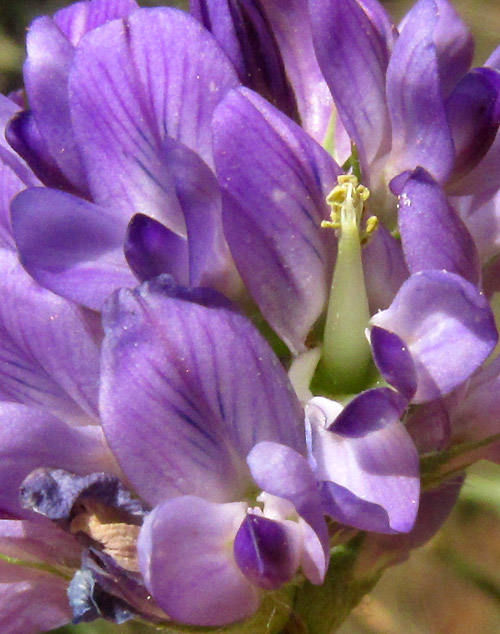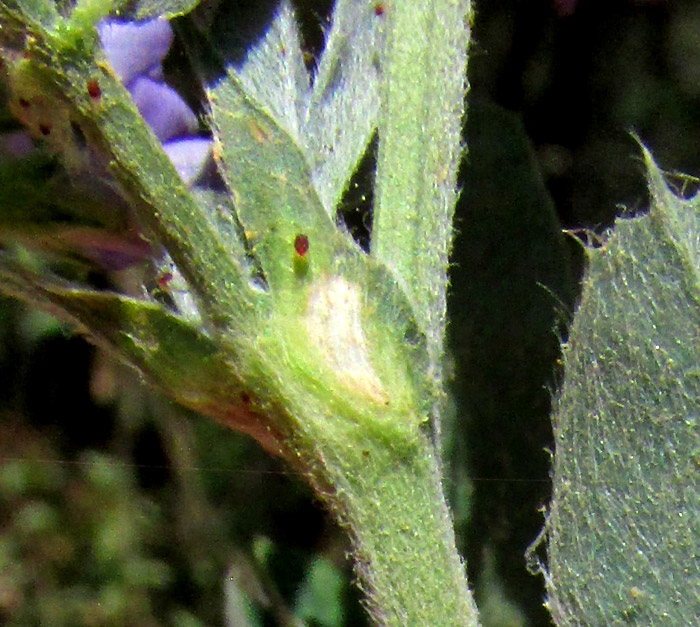Excerpts from Jim Conrad's
Naturalist Newsletter
Entry from field notes dated June 30, 2023, from small gravel road along east-facing slope with pines and oaks, between El Socavón and El Suspiro, about 1 straight-line km SW of El Doctor; in the mountains of east-central Querétaro state, municipality of Cadereyta de Montes, 12 straight-line kms due east of Vizarrón de Montes but much farther by twisting roads; elevation ~2500m (~8200 ft), Querétaro, MÉXICO, (N20.84873°, W99.58145°)
NATURALIZED ALFALFA

Beside the narrow gravel road running along a steep, east-facing slope through pine/oak forest, I was looking for unusual plants in hard-to-reach, seldom studied country. The above violet-flowered herb, much branched from the base and with stems so weak it couldn't stand upright without leaning on neighbors. The plant looked familiar, but to make sure it wasn't something unusual, it was worth "doing the botany."

With the flowers' corollas being strongly bilaterally symmetrical, and the leaves divided into three leaflets, even at first glance it looked like a member of the vast Bean Family.

Above, most clearly seen on the bottom-most flower, each corolla consisted of a large top petal, two petals on each side, and two bottom petals with their common margin fused, so that the petals form a scoop- or boat-shaped lower lip. That's exactly the basic structure of flowers on garden bean vines. On the flower on the picture's right side, the white item is a staminal tube consisting of nine of the stamens' fused-together filaments, topped by white, pollen-producing anthers; behind the tube, a tenth stamen stands apart from the structure. Stamens with this curious arrangement are said to be diadelphous, and it's also to be seen on flowers of garden beans and peas.

Each flower arose on a short stem, or pedicel, attached to the inflorescence stem, or rachis, so these were raceme-type inflorescences. The calyxes were a little asymmetrical, but not much, and soft-hairy. Each flower's pedicel was subtended by a slender, pointed, scale-like bract.

Leaves were trifoliate -- divided into three leaflets. Above, note that the middle leaflet bears its own little stalk, or petiolule. For identification purposes, an important feature of the leaflets is that their tips bear several sharp teeth. A relatively small number of Bean Family members possess such toothed leaflets, but some of the most important agricultural crops do, such as clover, sweetclover and alfalfa. Here's what the stipules looked like:

Above, the stipules are the two rabbit-ear-like structures at the base of the petiole pointing to the image's top, left. At the picture's right you see better a leaflet's upper tooth, and lots of soft, white hairs hugging the leaflet's surface.
In our part of upland central Mexico, if you have a Bean Family member with trifoliate leaves whose leaflets display at their tips such teeth as ours, the middle leaflet is stalked on a petiolule, and the corollas are strongly bilaterally symmetrical, you have a member of the genus Medicago. That genus contains at least 87 species, native mainly to the Mediterranean basin area. Several species are important forage crops. In our upland, central Mexico region, three species might be expected, all from the Old World, species which have escaped into the wild here to become naturalized.
In our area, if you have a Medicago with bluish or purplish flowers, your plant is MEDICAGO SATIVA, famous worldwide as what in English is called Alfalfa or Lucerne. The name Lucerne apparently honors the Swiss town of Lucerne, from which early introductions of the plant originated. The English name Alfalfa is borrowed from Spanish, and the Spanish name is based on the Arabic al-faṣfaṣa, meaning "green fodder." The binomial Medicago sativa is an old one bestowed by Linnaeus himself, in 1753. Alfalfa is thought to have originated in south-central Asia and, according to Pliny, was introduced into Greece in about 490 BC. It's an amazing forage; in this area farmers can harvest six cuttings from it in one year.
Not being native, in Mexico there's little tradition of using Alfalfa medicinally. Still, the plant is sold as an herbal remedy, mainly for various kidney problems. Also to calm the nerves, for the cough, for "hot stomach," and it's taken for its vitamin and mineral content. If you want to be astonished by all the curative and healthy effects that have been clinically confirmed -- too numerous to list -- check out the 2021 study by Ali Esmail Al-Snafi and others entitled "A review on Medicago sativa: A potential medicinal plant."
On the other hand, if a human or any other animals eats too much of it, Alfalfa is toxic, the primary poisons being canavanine and saponins. Cattle, chickens, sheep and humans are reported as the most affected. Large animals may relish alfalfa so much that they overeat and get so bloated with gas that they die.
One of the most promising and important uses of Alfalfa is that of phytoremediation. Phytoremediation is the use of green plants to clean up soil, air and water contaminated with hazardous substances such as toxic metals like cadmium, lead and aluminum, as well as pesticides, solvents, explosives and crude oil.
And who knows how an Alfalfa plant ended up along a narrow gravel road through pine/oak woods on a hillside in mountains where there's not enough level land for farming or pastures? A good guess is that someone passed by with a pickup truck loaded with bales of Alfalfa hay for his critters kept in little pens, and a single seed escaped.